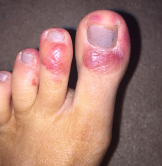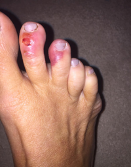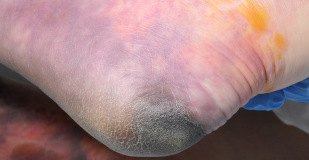As we gain more experience and knowledge surrounding COVID-19, new symptoms of the virus continue to be identified. One such symptom has been dubbed ‘Covid Toes’. Additionally, vascular teams in particular are seeing more patients with acute limb ischemia and perfusion injuries, all of which are related to the COVID-19 virus.
What are ‘Covid toes’?
‘Covid toes’ is a type of dermatological manifestation of COVID-19 which has been increasingly reported in the media and medical literature. While viral infections causing rashes and eruptions on the skin are not uncommon (e.g. chicken pox), what is surprising is the number of patients experiencing red or purple tender areas of discolouration of the toes. ‘Covid toes’ appears as asymmetrical lesions and can look very similar to chilblains (see Covid toe images below).


Covid toes symptoms
Patients can experience burning sensations, itching with pain or tenderness around the affected areas. These lesions do not seem to be in correlation with the severity of the illness associated with the virus, in other words these can be seen on patients who have mild symptoms of COVID-19 and go on to make a complete recovery within a couple of weeks – this includes the pain and discolouration in the feet returning to normal. The lesions have also been reported in patients who do not exhibit any other symptoms, particularly in children or young adults. It is vital that anyone presenting with any such symptoms, are tested for COVID-19, even in the absence of any other symptoms.
The true physiological process which causes these lesions to occur is not yet understood but there are theories which believe this may simply be as a result of the inflammation caused by the virus or be linked to micro embolisation.
In addition to causing severe respiratory problems, COVID-19 also brings with it abnormalities in blood clotting, with patients being at increased risk of DVT and PE due to their hypercoagulable state, it has been reported that around one in four coronavirus patients admitted to ICU will develop a PE (Llitjos et al., 2020). These rates are much higher than you would normally see. One potential explanation for this is that the virus is directly impacting and changing the cell lining of the blood vessels, this combined with an activated immune system results in the formation of thrombus. Increased incidence of thrombosis has also been seen in the arterial supply, this has resulted in increased numbers of patients with Acute Limb Ischaemia (ALI) in patients with positive COVID-19. One hospital reported the incidence of ALI have increased from around 1.8% to 16.3% (Bellosta et al., 2020).
In the sickest of patients, those on ICU requiring significant support, there is a risk of perfusion injury, symmetrical peripheral gangrene is a rare condition caused by acute ischaemia but with no vessel occlusion (images below), caused by the drugs used to keep the patient alive.
What do Covid toes look like?


Covid toes treatment / management
Intravenous vasopressors (eg dopamine, noradrenaline) are frequently used to manage a haemodynamically unstable patient. Vasopressors work by vasoconstriction, concentrating the blood supply to the major organs but subsequently may cause decreased perfusion of peripheries, especially digits.
Covid toes – what to look for
COVID-19 has caused major challenges within the NHS and will continue to do so. Practitioners need to have raised awareness of patients’ feet: How changes in digit colour could be a sign of infection, even in the absence of any other systems; that patients positive of COVID-19 have an increased risk of acute limb ischaemia; and that the sickest of patients tissue perfusion need closely monitored to prevent tissue loss.
References
Bellosta, R, Luzzani, L, Natalini, G., Pegorer, MA, Attisani, L, Cossu, L. G, Ferrandina, C, Fossati, A, Conti, E, Bush, RL & Piffaretti, G 2020. Acute limb ischemia in patients with COVID-19 pneumonia. Journal of vascular surgery, S0741-5214(20)31080-6.
Llitjos, J-F, Leclerc, M, Chochois, C, Monsallier, JM, Ramakers, M, Auvray, M & Merouani, K 2020. High incidence of venous thromboembolic events in anticoagulated severe COVID-19 patients. Journal of Thrombosis and Haemostasis, n/a.









